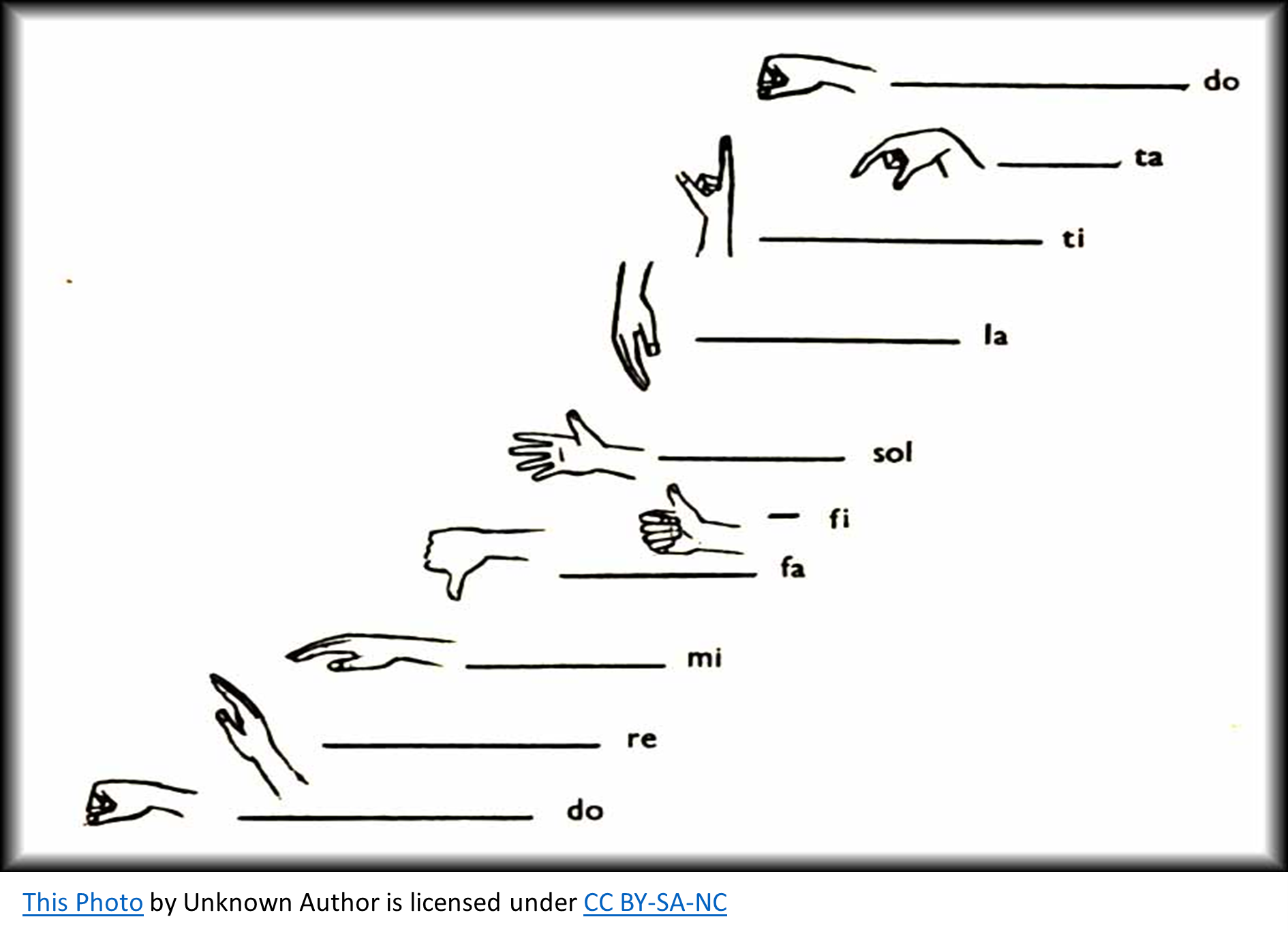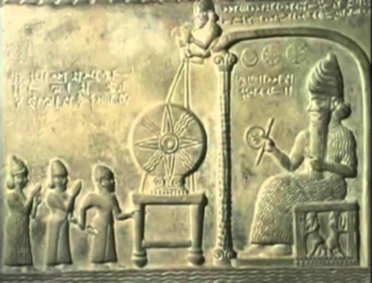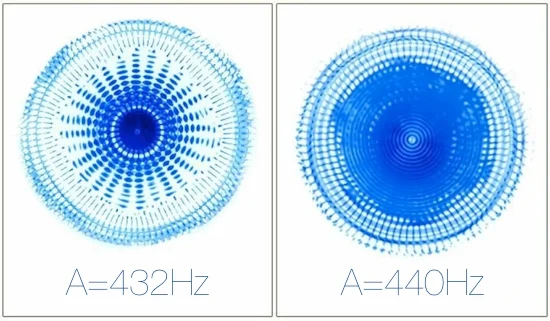Step into the wonderful world of cymatics where we visualize "music in motion." Because everything (all matter) has a resonant frequency, everything in the universe can all be expressed in musical form. Cymatics is one way the ancients could "notate" the visual aspects of music. Is it possible cymatics is an early form of musical notation?
The information for this article is taken from Lesson 10 of my Frequency Basics course. The course will be made available as a download through Gumroad soon. Those who've already paid for Frequency Basics on the forum will receive full access to the downloads at no extra cost to you. For those who are interested in the course, check the TEACHINGS page in early December 2023.
Moving along to fascinating information that connects cymatics with music and motion...
We begin with a video of singing into a Cymascope. Watch carefully as the shapes dance around, fading in and out between shapes. At times, the shapes are a bit fuzzy. We'll explain later why this occurs.
Imagine that you’re an ancient Sumerian who wants to notate musical frequencies or a simple melody. How do you do it? Was it even possible during their day? Musicologists have said that musical notation didn’t appear until about 1,000 AD during the time of Guido D’Arezzo, who invented solfege (Ut, Re, Mi, etc.). His method of teaching his students led to our current system of musical notation. Before that, lines, squiggles, and a myriad of other marks (neumes) indicated pitch direction only.
We’re told there was no way of determining the starting pitch or intervals between notes. With cymatics, we’ll discover a form of musical notation, present in nature, that allows us to determine exact pitches.
In Figure 1, we see the hand signs associated with our modern musical scale for solfege. Zoltan Kodaly created these hand signs as part of his teaching method for children. His goal? Teach musical literacy in schools using our natural instrument – the voice. "Solfege" is taught using these signs. Musicians know where to place the notes within a scale based on these hand signs. There is evidence that the Egyptians used some form of hand signs to determine pitches.

Figure 1
Cymatics is a visual representation of sound. If you can figure out which cymatics pattern matches a specific frequency, the exact concert pitch can also be determined. It appears the ancient Sumerians, as well as other ancient civilizations, probably understood how to capture musical pitches in picture form as shown on the disk in Figure 2. However, we didn’t call it cymatics until Hans Jenny “named” it in the late 1900’s. It works like this… put sand, powder, or something similar onto a membrane that’s stretched over a resonating chamber, sing/play a note, and the membrane responds to that sound by creating a shape. Some believe this is how the pictographs of the Hebrew letters were formed. Pictographs and sound are further explored in Lesson 21 of Frequency Basics.

Figure 2
In Figure 2, look closely at the sun disk sitting on a table in front of a god on a bench/throne(?). Acoustical specialists say the image carved onto the disk is a cymatics shape. If you can figure out what frequency creates that shape, you’ll know what pitch to sing. Therefore, some scientists believe cymatics was indeed an early form of musical notation through pictures. As you'll see next, I was able to figure it out, thanks to a YouTuber who had the same curiosity that I do. Unfortunately, I didn't save the link to that video. Maybe someone else can find it?
Let’s revisit the first video at the beginning of this article using a CymaScope. It’s titled “CymaScope video projected in Trinity Episcopal Cathedral.” I've posted it here again so you don't have to scroll up to access it. As you watch the video, notice that the shapes fade in and out of “focus.” This happens as the CymaScope appears to “lock in” the pitch and again when a pitch begins to fade. What do you see in the shapes as the cymascope recognizes changes in notes within the chord of the choir? How do the shapes respond when a steady pitch (or pitches) are sung? How does it respond when a chord is sung? What do you think causes the shapes to change when the pitch does NOT change?

Figure 3
Did you notice in the video from the cathedral that the shapes fade in and out of focus? Figure 3 is a still shot. We don’t know at what point of the play-and-decay process these photos were taken. What instrument (or voice) was used to create Figure 3? There’s no way to determine from this image if A=440 is that different from A=432. When I Googled the image, many websites use this exact picture to “prove” A=440 is harmful. A scientific mind will think, “when were the pictures taken and what instrument was used?” I tested this image using my CymaScope app to see if I could get the same pictures.
If you want the Cymascope app to do your own experiements, CLICK HERE.
I played the A above middle C in A=432, 440, and 444. I also played several other notes using all three concert pitches to see how shapes fade in and out during the duration of a pitch. I can get the shape on the right (440Hz) in ALL notes in ALL concert pitches as a tone morphs in and out of various shapes within a given pitch. Remember that every note has harmonics above the fundamental. Therefore, the CymaScope will “hear” the notes above the fundamental and “show” those notes in picture form based on the instrument/voice it's hearing. As the harmonics are heard, there’s a transition from one shape to the next. The transitions often include fuzziness in a Cymatics image.
Why do the shapes change even when a single note is sung? Because every note has harmonics above the fundamental frequency. When singing into a Cymascope (probably not the app because it's pre-programmed for specific pitches on a piano), no two people's voices will be the same. Why is that? We each have our own individual "voice print" where the strength of each harmonic will differ. Because we don't know what instrument (or voice) was used to create the image in Figure 3, it will be difficult to replicate it exactly in a CymaScope 3D image, such as shown in Figure 3. Chaldni plate 2D images won't show the harmonics until the actual harmonic note is played. Chladni plates represent one note at a time while a CymaScope image includes the harmonics that "settle" within layers of a CymaScope image. Remember... the ancients didn't have a CymaScope so the only images they could copy are in 2D.
Now, let's look at a single male singer. This next video is posted on the “Videos” tab on John Stuart Reid’s website (www.soundmadevisible.com.) To watch the video, CLICK HERE. Notice the man sings the same pitch while shifting vowels. The shapes clearly change and sometimes, the image fully blurs out, similar to the A=440 picture above. This is how the CymaScope appears to respond when there are adjustments in pitch, vowel shape, voice type, and tonal quality. Because so many factors are involved when creating an exact cymatics shape, this demonstrates how people can take something and misrepresent it when trying to prove a point. A=440 is no different than any of the other concert pitches on my CymaScope app. Yes, the shapes vary but all pitches, no matter the concert pitch, show beautiful shapes. For every note that I “sampled” on the CymaScope app, there were points where no shape was evident as the CymaScope tried to read the nuances between the fundamental and its harmonics.
Conclusion
As seen in many videos across YouTube, cymatics shapes are formed by sound. For cymatics shapes in crop circles (Lesson 19 in Frequency Basics), some say this energy comes from within the earth itself. In some of my original articles, I thought cymatics in crop circles are formed through wind refraction but now I’m not so sure. Either way, cymatics shows HOW sound moves in a visual format. The CymaScope demonstrates the movement process in 3D while a Chladni plate reproduces an image in 2D. We see 2D shapes on turtle shells along with other places in nature.
The size and shape of a Chladni plate can also affect what a shape looks like because it, too, will have a fundamental frequency. Only the notes within the harmonic series of the Chladni plate's fundamental frequency will appear in shape form. For those who are in the Frequency Basics class, you'll understand why it took so long for acoustic specialists to find the exact shapes on a Chladni plate that are replicated in the cubes of the Rosslyn Chapel (Lesson 20).
Next, it’s important to carefully weigh all the information that’s put before us concerning our learning process. We are supposed to question discoveries, making sure we have a view of the overall picture before coming to conclusions. Let’s NOT do what was done in Figure 3 where someone creates an image specifically to hammer out a point. We are created to be curious and should constantly be seeking truth. What I may believe today, I may not believe tomorrow because I have better information today than I did yesterday. We can hypothesize until enough information comes. THEN a decent conclusion can be reached.
Concerning the A=432 vs A=440 picture in Figure 3, I can safely say through my own experimentation that ALL notes on a Cymascope will "fuzz out" as a pitch fades or the device recognizes one of the harmonics evident in a specific pitch. It's quite sad that so many people have taken this image and run with it as proof A=440 is harmful. If A=440 is that bad, then my entire being would be a total mess from playing classical music tuned to A=440. I'm perfectly healthy! As I've said before and will continue to say, our thoughts and intents frame our world. We get what we believe...
Del Hungerford, November 2023
NOTE: None of the information in this series or any other article on this site may be used without permission! You may share the articles but if you wish to quote my work in your own writing, it is "good form" to cite any materials that aren't your own.
Frequency Basics Course
The "new and improved" Frequency Basics course will be available as a download on the Healing Frequencies Music website from the TEACHINGS category on the Shop page NO LATER than the middle of December 2023. Those who have already have access will receive an email with a link to download the course at no extra cost because you've already paid for it. The regular price for all 30 lessons is $125.
Lesson Topics:
- #1: Frequency Made Simple
- #2: Concert Pitch vs Temperament: Why Should You Care?
- #3: Learning to Feel Sound
- #4: Concert Pitch vs Temperament: Was There a Conspiracy?
- #5: Reader's Digest Version of Music History
- #6: Natural Laws of Music and Harmonics
- #7: Ancient Solfeggio Frequencies: They're Not What You've Been Told!
- #8: Connecting Dots With Numbers
- #9: Chromotherapy: Healing With Color
- #10: Cymatics: Visualizing Sound (part of this lesson is in this article)
- #11: Water Memory: Healing Through Water
- #12: Thoughts and Intents Frame Our World
- #13: Healing Cancer: Royal Raymond Rife
- #14: Healing Powers of Music
- #15: Entrainment and Entanglement
- #16: Archaeoacoustics: What the Ancients Knew
- #17: Archaeoacoustics: Sound in Stone
- #18: Ed Leedskalnin and the Mystery of Coral Castle
- #19: The Mystery of Crop Circles
- #20: Cymatics Shapes in Rosslyn Chapel
- #21: Healing Properties of the Great Pyramid of Giza
- #22: Healing Through the Musical Frequencies of the Hebrew Letters
- #23: Healing Through Flower Essences, Music Essences, and Essential Oils
- #24: How Does Sacred Geometry Fit into this Picture?
- #25: Quantum Physics Made Easy
- #26: Rhythm, Melody, and Harmony: The Government of Music
- #27: Is it Possible to Reprogram our DNA?
- #28: Consciousness is a Frequency
- #29: The Frequencies of Creation Made Easy
- #30: Connecting the Dots...
Lessons come with experiments, a few assignments, and the opportunity to get feedback from me! All materials (about 300 pages total) are downloadable with clickable links to every video, article, and website.

